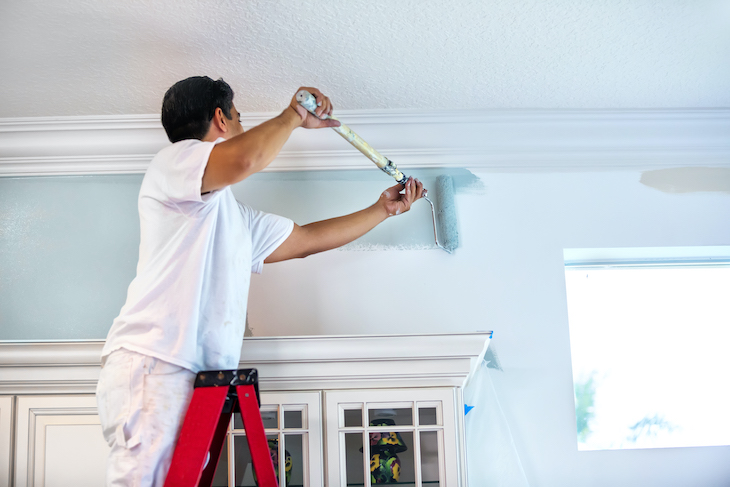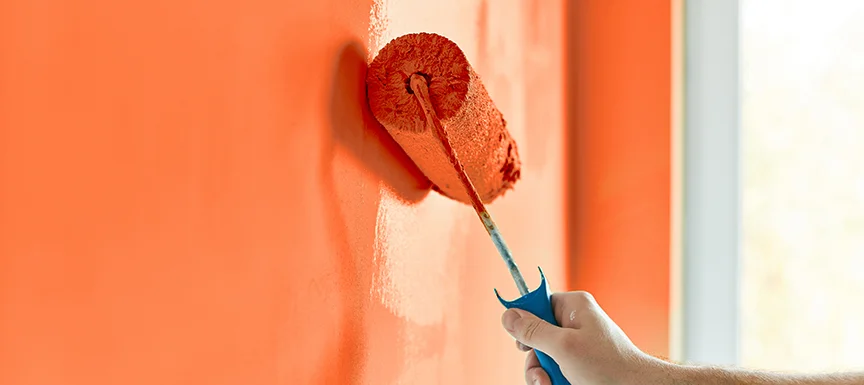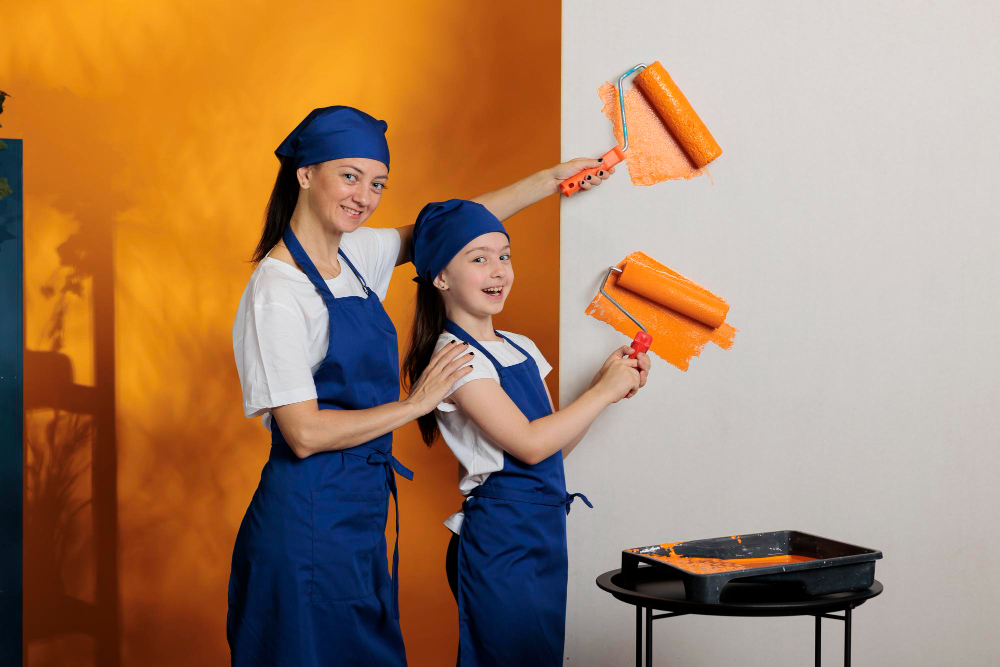Stay Ahead With New Paint Trends: Blending Methods for Modern Interiors

The Increase of Shade Gradients in Interior Design
As designers progressively look for innovative means to enhance areas, the surge of color slopes in interior decoration has actually amassed considerable focus. This technique, defined by the smooth change in between two or more shades, permits a dynamic aesthetic effect that can transform a regular area right into a vibrant atmosphere. Shade slopes can stimulate emotions, influence understandings of area, and develop centerpieces, making them a versatile option for numerous layout styles.
The application of slopes prolongs beyond walls; they can be properly used in furnishings, fabrics, and devices. Designers typically trying out differing tones to attain deepness and intrigue, appealing to a series of aesthetic appeals from minimalist to diverse. On top of that, the flexibility of slopes allows their usage in both business and domestic settings, accommodating diverse clients. As patterns develop, making use of color slopes symbolizes a change towards more expressive and personalized interior spaces, mirroring private tastes and way of lives.
Embracing Ombre Strategies for a Dynamic Look
Ombre strategies have become an enchanting choice for those looking to include depth and activity to modern-day interiors. This gradient result changes smoothly from one color to another, creating an aesthetically striking centerpiece in any area. Developers value ombre for its versatility; it can be related to walls, furnishings, or perhaps decorative accents, enabling one-of-a-kind expressions of design.
The method works specifically well with soft colors, giving a tranquil atmosphere, while bold shades can invigorate an area. Property owners can experiment with various shade schemes, picking different shades for a dramatic impact or unified tones for a subtle result. The application of ombre is not restricted to a solitary wall; it can prolong throughout a room, improving the assumption of space and light.
As a modern trend, ombre techniques satisfy diverse tastes, enabling individuals to personalize their interiors and welcome creativity in their layout method. benjamin moore paint store corpus christi.
Distinctive Wall Surfaces: Layering Paint for Deepness and Interest
Textured wall surfaces can substantially enhance the visual allure of modern interiors by adding deepness and rate of interest. Strategies for developing texture, thoughtful shade mixes, and the right devices for layering are crucial parts in attaining this impact. Checking out these components enables a customized and dynamic method to indoor design.
Techniques for Texture Creation
Creating visual rate of interest in interior areas typically pivots on the artful application of texture. Various methods can be utilized to attain this, such as sponging, rag rolling, and stippling. Sponging involves utilizing a moist sponge to apply a second color over a skim coat, developing a soft, multicolor impact. Rag rolling, on the other hand, utilizes a rolled cloth to apply paint, leading to a much more dynamic texture. Stippling employs a rigid brush or device to dab paint onto the surface, producing a distinct pattern. Furthermore, layering different finishes, such as matte and glossy, can improve deepness. These methods not only offer aesthetic allure however also add to the general ambiance of modern interiors, encouraging a responsive experience.
Shade Combinations for Effect
Layering paint not only boosts structure yet also opens a world of color combinations that can substantially influence the mood of an area. By blending complementary tones, developers can develop a harmonious result that invites heat or coolness, depending upon the preferred atmosphere. For example, abundant earth tones coupled with soft pastels can evoke a calm atmosphere, while vibrant, contrasting colors can include vibrancy and power. Furthermore, incorporating metallic or shiny coatings within the layers can introduce a vibrant visual element, catching light and enhancing the deepness of the shade scheme. Inevitably, thoughtful shade combinations with layering paint provide a possibility to reveal specific style while transforming ordinary walls into enchanting prime focus.
Devices for Layering Impact
Various tools Read Full Report are crucial for attaining a successful layering impact in paint applications, which can change wall surfaces right into captivating aesthetic experiences. Brushes and rollers are fundamental, with diverse sizes enabling different structures and surfaces. Specialty tools like dustcloths and sponges can develop special patterns and deepness, while combination knives provide accuracy for even more specified lines. For larger locations, making use of a stippling brush can add a detailed finish. In addition, spray weapons can effectively use numerous layers for a smooth, also coat. Painters must likewise think about painter's tape to develop tidy edges in between layers. By utilizing the right tools, one can successfully enhance the visual allure of interiors, making each wall a fascinating focal factor.

The Power of Color Obstructing in Modern Spaces
As contemporary indoor design remains to develop, color obstructing becomes an effective technique that can change areas with bold aesthetic influence. This technique includes the calculated placement of contrasting shades to create defined zones within an area, improving both the visual appeal and performance of the area. corpus christi paint store. By making use of huge swathes of shade, developers can assist the eye and highlight building components, causing a dynamic atmosphere
Color stopping is not limited to walls; it can also be applied to furniture and decoration, permitting for endless modification. Combining a vivid tone with a neutral tone can develop a striking focal factor while keeping equilibrium. This method urges imagination, allowing house owners to share their individualities through distinct color mixes. Inevitably, shade obstructing functions as an effective means to rejuvenate contemporary interiors, making spaces really feel fresh, energised, and aesthetically engaging.
Incorporating Metallics for an Extravagant End up
Exactly how can metallics raise the sophistication of contemporary interiors? Metal surfaces serve as a striking prime focus, including deepness and visual rate of interest to spaces. They can transform a typical room into an elegant hideaway with the subtle interaction of light and reflection. Developers commonly suggest incorporating metallics in accent wall surfaces, ceilings, or furniture to develop an extravagant environment without frustrating the area.
Different metal shades-- such as gold, silver, and bronze-- offer adaptability, permitting homeowners to personalize their aesthetic. A soft gold can give warmth, while a smooth silver can offer a contemporary touch. When coupled with neutral tones, more metallics enhance the general design, supplying an innovative contrast that draws the eye.
Including metallic paint into trim or moldings can likewise boost architectural details, developing a polished surface. Eventually, the strategic use of metallics can infuse contemporary insides with prestige and refinement, making them really charming.
Creative Use of Stencils for One-of-a-kind Patterns
Transforming walls with patterns can instill modern-day insides with distinctive character and design. This imaginative strategy allows designers and property owners to produce personalized patterns that reflect personal aesthetics. Patterns can range from complex geometric layouts to wayward themes, making it possible for a large selection of expressions. By choosing contrasting colors, stencils can raise a space's visual appeal and function as focal points without frustrating the area.
Patterns are flexible; they can be applied to different surfaces, including wall surfaces, furnishings, and also ceilings. This versatility makes stenciling an excellent selection for do it yourself fanatics seeking to improve their space economically. Furthermore, the simplicity of application and removal allows for experimentation, enabling important site people to rejuvenate their design with very little initiative. Eventually, innovative use of patterns not just transforms average surface areas however also provides a possibility for self-expression, making them a trending option in modern indoor style.
Blending Matte and Shiny Surfaces for Comparison
The interaction of matte and glossy coatings can produce a striking aesthetic dynamic in contemporary interiors. Developers typically utilize this comparison to enhance building functions and define rooms. Matte coatings, with their soft, non-reflective top quality, can create a feeling of warmth and affection, making them optimal for walls and bigger surface areas. In contrast, shiny finishes show light, adding vibrancy and depth, making them ideal for accents such as trim, moldings, or furniture.
The mix of these textures can assist the eye and emphasize prime focus within an area. For example, coupling a matte-painted wall with glossy cabinetry can develop a sophisticated equilibrium. Furthermore, the mindful application of both surfaces can stimulate different moods while enhancing the general aesthetic. As house owners progressively look for customized rooms, blending matte and shiny coatings uses a functional technique to attaining contemporary style and aesthetic interest in interior decoration.
Often Asked Concerns
What Devices Are Best for Mixing Paint Techniques?
A selection of tools are ideal for mixing paint methods, including foam rollers, brushes with soft bristles, sponge applicators, and airbrushes. Each device gives special results, enhancing the mixing process for various creative applications.
How Can I Fix Mixing Mistakes?
To fix mixing mistakes, one should gently sand the damaged location, apply a primer if required, and afterwards meticulously reapply paint utilizing a soft brush or sponge to achieve a smooth shift and bring back the desired result.
Exist Details Paint Brands Recommended for Mixing?
Numerous paint brand names are advised for mixing, consisting of Benjamin Moore, Sherwin-Williams, and Behr. These brand names supply high-grade coatings and a variety of colors that facilitate smooth shifts and efficient mixing techniques in various interior projects.
Can I Mix Paint Without Professional Assistance?
Yes, mixing paint without specialist assistance is possible. With practice and the right tools, people can achieve desirable effects. Different online tutorials and overviews can help in mastering mixing methods for individual tasks.

The Length Of Time Does Blended Paint Last on Walls?
Mixed paint can last anywhere from 5 to 10 years on walls, depending upon elements such as the high quality of paint used, surface prep work, and environmental problems. Regular upkeep generally enhances long life and appearance.
As designers significantly seek ingenious means to boost rooms, the rise of color gradients in interior layout has amassed considerable focus. The strategy functions specifically well with soft shades, providing a calm setting, while bold colors can invigorate a room. Strategies for creating texture, thoughtful color mixes, and the right tools for layering are vital parts in attaining this result. Layering paint not only boosts texture but likewise opens up a globe of color combinations that can substantially influence the state of mind of an area. As modern interior style continues to develop, shade obstructing arises as an effective strategy that can change rooms with strong aesthetic influence.